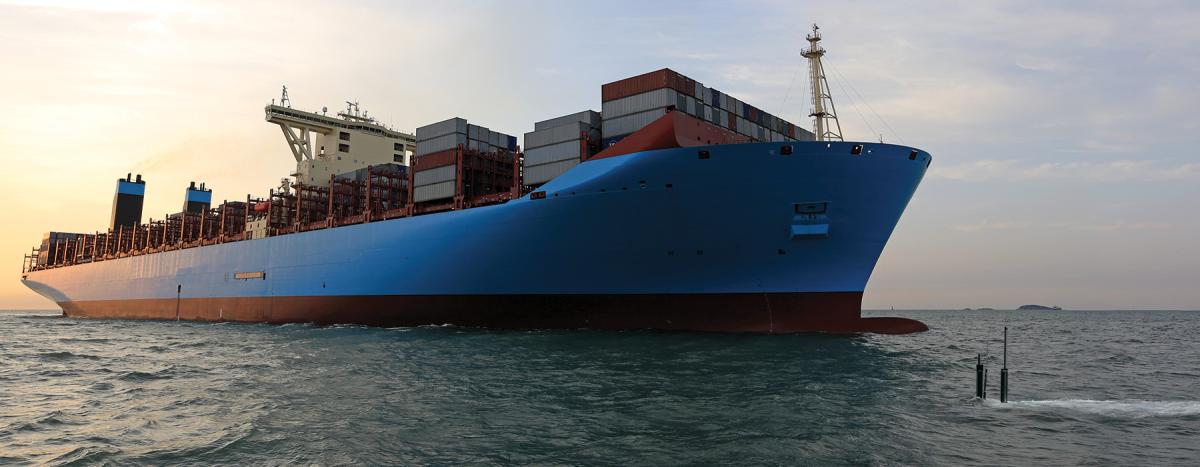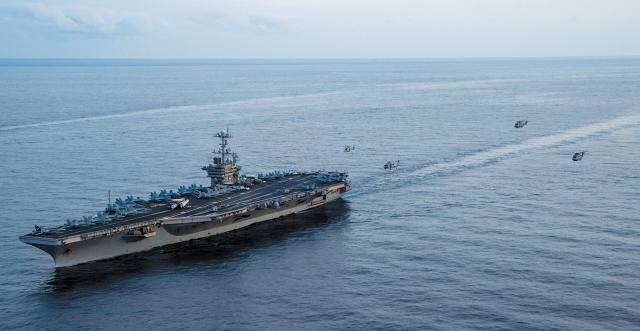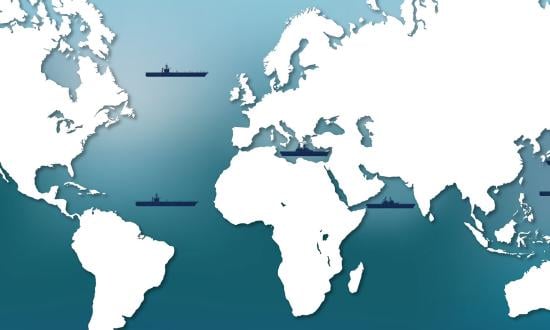The United States will soon find in China the greatest potential adversary it has ever faced. Many can theorize about tactics and outcomes, but only one thing is certain: If the United States and China fight in the western Pacific, ships will be destroyed and sailors killed in numbers reminiscent of World War II. To prevent the start of such a conflict, the United States must increase its anticommerce warfare capabilities and target China’s extended sea lines of communication—and a large relatively undefended merchant fleet. Anticommerce warfare is feasible and based on a historical understanding of sea control and a Mahanian application of the Navy’s diplomatic purpose.
To understand the importance of commerce warfare against the Chinese merchant fleet, the Navy’s purpose must be understood beyond modem sentiments around “freedom of navigation” and conventional warfare. British naval thinker Sir Julian Corbett wrote, “The object of naval warfare must always be directly or indirectly either to secure the command of the sea or to prevent the enemy from securing it.”1 The Navy uses resources to protect international commerce in peacetime, but unless changes in thought and budget are made, it will lack the ability to restrict commerce in war.
When most Americans hear “command of the sea,” an Army-centric mind-set takes over. The United States expects to own the sea like the Army occupies land, while not considering Corbett’s warning: “You cannot conquer sea because it is not susceptible to ownership.”2 The primary use of the sea is not solely the destruction of the enemy’s navy or freedom of navigation. A navy also must be able to restrict the enemy’s ability to benefit from sea commerce.
The surface warfare community plays a critical role in the Navy’s own mission statement: “The mission of the Navy is to maintain, train and equip combat-ready Naval forces capable of winning wars, deterring aggression and maintaining freedom of the seas.”3 This mission needs to be studied through Corbett’s view of sea command. First, it implies the surface fleet is fighting and winning battles. Even if the Navy is to “defeat the enemy’s fleets as we may, he will be but little the worse,” unless further action can be taken.4 Second, capitalizing on an inability to protect shipping is critical if the U.S. surface fleet’s mission of “deterring aggression” is to be achieved. Even if the U.S. Navy can sink the entire People’s Liberation Army Navy (PLAN) fleet, it is not a viable deterrent to aggression unless there are additional consequences.
Corbett taught the importance of “the power to strangle the whole national life. It is not until this is done that a high-spirited nation, whose whole heart is in the war. will consent to make peace and do your will.”5 The ability to control what can sail over the ocean is the greatest asset to peace the United States can have. In facing the reality of what it will take to compel China to preserve peace, the traditional role of the U.S. surface fleet of “maintaining freedom of the seas” cannot be a limitation. The truest deterrence to war is not the assurance of U.S. maritime freedom in the South China Sea or far western Pacific, but the destruction of such freedom for China on U.S. terms, all around the world.
China’s Primary Vulnerability
Preparing for far-reaching and intense commerce warfare operations will make many naval officers uncomfortable. There is a powerful faction within the naval community convinced that a Sino-American war is unavoidable, while still being thoroughly entrenched in a stereotypical Mahanian desire to decide a future conflict with a decisive fleet engagement. The destruction of the enemy fleet is good, but it is not good enough. The shift to an aggressive new mindset of deterrence based on commerce destruction is needed to provide U.S. diplomats with the strength to compel peace with China, beyond the threat of tactical victory in an area where the Chinese have the homefield advantage.
History shows acceptable peace will only be found through a position of strength. Developing anticommerce warfare would provide strength to the Navy to harm the thing the Chinese Communist Party (CPC) cherishes the most: Its economic success. The greatest love of the CPC is not its people or sailors, who by historic precedents it would gladly sacrifice in mass if victory was possible. The regime depends on economic growth to survive. Retired Marine Corps Colonel Mark Cancian and Brandon Schwartz wrote in Proceedings on a similar subject. “Chinese social stability is built on a trade-off: The Chinese Communist Party has told the people they will not have democratic institutions, but they will receive economic prosperity.”6
Just because the Navy can no longer freely operate a carrier off the coast of China does not mean it cannot supply U.S. diplomats leverage to compel China to seek peaceful resolutions to disputes. At the end of the day, it will be representatives from both countries talking face to face and finding resolutions will preserve peace. For the Navy to incentivize China to seek peaceful resolutions over continued military aggression, it must have the ability to threaten the very existence of communist rale in China with commerce denial.
There are few individuals who better understood the power the Navy could give to diplomats than Alfred Thayer Mahan. Mahan understood “war is the last argument of diplomacy.”7 Mahan further realized there was a great opportunity for the Navy, because “diplomats do not flourish such disagreeable truths in each other’s faces: They look for a modus vivendi, and find it.”8 The disagreeable truth that preserves peace is a circumstance in which the consequences of diplomacy’s last argument would be catastrophic for both sides.
The potential consequences to China of fighting the U.S. Navy directly are still great but decreasing fast. Every year China grows more confident in its naval and missile abilities, closing an ever-smaller strength gap with the United States. The United States needs additional options to pressure China at sea besides the prospect of an ever-more dangerous fleet engagement in the far western Pacific. Critics will say a true commerce warfare capability is an unattainable goal, yet there are many options and programs available within the Navy or allied navies to develop this peace-preserving ability.
Anticommerce Warfare Capabilities
There are unique opportunities in developing anticommerce warfare that would allow the United States significant and credible flexibility in targeting the Chinese merchant fleet. Investing now in cheaper, more numerous anticommerce weapons will be critical to maintain the threat to the Chinese economy if the U.S. Navy’s main combat forces were committed to conventional operations against the PLAN.
Vessel classes such as the littoral combat ship (LCS), the Mark VI patrol boat, and other smaller combatants could find a practical use in hunting commerce. The Mark VI patrol boat is one of the smallest and cheapest surface assets in the Navy, and it has demonstrated a range of at least 500 miles, with an unclassified range of 600 miles as recently as 2019.9 These classes and others like them could be used to conduct aggressive visit, board, search, and seizure (VBSS) operations in China's sea lines of communication. Capturing shipping could serve as political leverage for peace and as a material supplement to the U.S. war effort. Increasing VBSS operations beyond their normal law enforcement functions could prove to be a valuable deterrent.
While there are those who would scoff at the idea of Navy surface forces engaging in commerce warfare, they would be foolish not to also consider the incredible power of the submarine force and naval aviation in anticommerce operations. During World War II, U.S. submarines sank more than 1,100 Japanese merchant vessels and 200 warships, while a combination of land- and sea-based aircraft sank an additional 800-plus merchant ships and inflicted tremendous losses on the Japanese battle fleet.10
However, today’s Navy nuclear-powered submarine and carrier forces are far too small and expensive to be put to work raiding commerce during a major war. Since many U.S. allies operate cheaper nonnuclear submarines very effectively, the United States could leverage their fleets. Submarines and antisurface warfare-armed traditional patrol aircraft would complement U.S. Navy and allied surface force commerce warfare strength. The potential payoff is too great to not consider such changes in traditional investments and strategies.
The capacity to decimate China’s merchant fleet is a serious step in response to the harsh realities of what war with China would mean for the United States. Any war with China will be started by China when it believes its position is such that the United States is unable to respond to its aggression with significant consequences. No matter what a Chinese first strike looks like, U.S. Navy and allied guerre de course assets strategically placed around the globe would ensure China is denied a quick victory. Taking steps now to ensure the United States can prevent China's use of the sea is well in line with the historical understanding of sea control and will give U.S. diplomats the leverage needed to preserve peace in times of extreme tension.
- Julian Corbett, Some Principles of Maritime Strategy (London: Longmans, Green, and Co., 1918), 91.
- Corbett, Some Principles of Maritime Strategy, 94.
- Naval Surface Force U.S. Pacific Fleet Public Affairs, “Our Navy’s Mission: How the Surface Forces Fit In,” Navy.mil.
- Corbett, Some Principles of Maritime Strategy, 98.
- Corbett, 95.
- COL Mark Cancian, USMC (Ret.), and Brandon Schwartz, “Unleash the Privateers!” U.S. Naval Institute Proceedings 146, no. 4 (April 2020).
- Alfred Thayer Mahan, Retrospect and Prospect: Studies in International Relations, Naval and Political (Boston, MA: Little Brown and Company, 1902), 142.
- Alfred Thayer Mahan, The Interest of America in Sea Power, Present and Future (London, England: Sampson Low, Marston & Company, 1897), 17.
- Ben Werner, “Mark VI Patrol Boats Sail 500 Nautical Miles in Record Transit,” USNI News, 12 January 2019.
- William P. Gruner, “U.S. Pacific Submarines in World War II,” Maritime.org.








